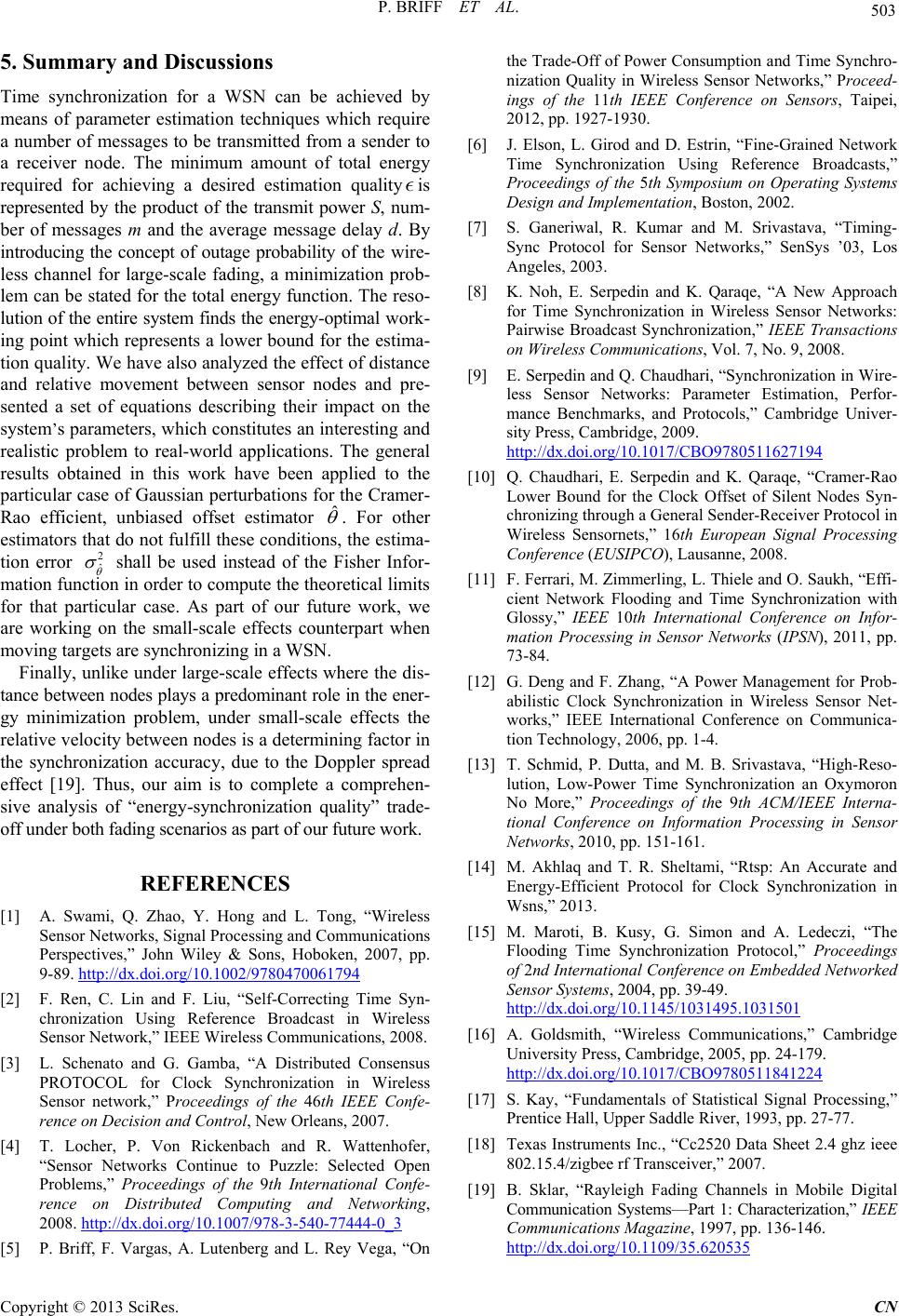
P. BRIFF ET AL.
Copyright © 2013 SciRes. CN
5. Summary and Discussions
Time synchronization for a WSN can be achieved by
means of parameter estimation techniques which require
a number of messages to be transmitted from a sender to
a receiver node. The minimum amount of total energy
required for achieving a desired estimation quality
is
represented by the product of the transmit power S, num-
ber of messages m and the average message delay d. By
introducing the concept of outage probability of the wire-
less channel for large-scale fading, a minimization prob-
lem can be stated for the total energy function. The reso-
lution of the entire system finds the energy-optimal work-
ing point which represents a lower bound for the estima-
tion quality. We have also analyzed the effect of distance
and relative movement between sensor nodes and pre-
sented a set of equations describing their impact on the
system’s parameters, which constitutes an interesting and
realistic problem to real-world applications. The general
results obtained in this work have been applied to the
particular case of Gaussian p erturbations for the Cramer-
Rao efficient, unbiased offset estimator
. For other
estimators that do not fulf ill these conditions, the estima-
tion error
shall be used instead of the Fisher Infor-
mation function in order to compute the theoretical limits
for that particular case. As part of our future work, we
are working on the small-scale effects counterpart when
moving targets are synchronizing in a WSN.
Finally, unlike under large-scale effects where the dis-
tance between no des plays a predominant role in the ener-
gy minimization problem, under small-scale effects the
relative velocity between nodes is a determining factor in
the synchronization accuracy, due to the Doppler spread
effect [19]. Thus, our aim is to complete a comprehen-
sive analysis of “energy-synchronization quality” trade-
off under both fadi ng sc enari os as part of our fut ure work.
REFERENCES
[1] A. Swami, Q. Zhao, Y. Hong and L. Tong, “Wireless
Sensor Networks, Signal Processing and Communications
Perspectives,” John Wiley & Sons, Hoboken, 2007, pp.
9-89. http://dx.doi.org/10.1002/9780470061794
[2] F. Ren, C. Lin and F. Liu, “Self-Correcting Time Syn-
chronization Using Reference Broadcast in Wireless
Sensor Network,” IEEE Wireless Communications, 2008.
[3] L. Schenato and G. Gamba, “A Distributed Consensus
PROTOCOL for Clock Synchronization in Wireless
Sensor network,” Proceedings of the 46th IEEE Confe-
rence on Decision and Control, New Orleans, 2007.
[4] T. Locher, P. Von Rickenbach and R. Wattenhofer,
“Sensor Networks Continue to Puzzle: Selected Open
Problems,” Proceedings of the 9th International Confe-
rence on Distributed Computing and Networking,
2008. http://dx.doi.org/10.1007/978-3-540-77444-0_3
[5] P. Briff, F. Vargas, A. Lutenberg and L. Rey Vega, “On
the Trade-Off of Power Consumption and Time Synchro-
nization Quality in Wireless Sensor Networks,” Proceed-
ings of the 11th IEEE Conference on Sensors, Taipei,
2012, pp. 1927-1930.
[6] J. Elson, L. Girod and D. Estrin, “Fine-Grained Network
Time Synchronization Using Reference Broadcasts,”
Proceedings of the 5th Symposium on Operating Systems
Design and Implementation, Boston, 2002.
[7] S. Ganeriwal, R. Kumar and M. Srivastava, “Timing-
Sync Protocol for Sensor Networks,” SenSys ’03, Los
Angeles, 2003.
[8] K. Noh, E. Serpedin and K. Qaraqe, “A New Approach
for Time Synchronization in Wireless Sensor Networks:
Pairwise Broadcast Synchronization,” IEEE Transactions
on Wireless Communications, Vol. 7, No. 9, 2008.
[9] E. Serpedin and Q. Chaudhari, “Synchronization in Wire-
less Sensor Networks: Parameter Estimation, Perfor-
mance Benchmarks, and Protocols,” Cambridge Univer-
sity Press, Cambridge, 2009.
http://dx.doi.org/10.1017/CBO9780511627194
[10] Q. Chaudhari, E. Serpedin and K. Qaraqe, “Cramer-Rao
Lower Bound for the Clock Offset of Silent Nodes Syn-
chronizing through a General Sender-Receiver Protocol in
Wireless Sensornets,” 16th European Signal Processing
Conference (EUSIPCO), Lausanne, 2008.
[11] F. Ferra ri, M. Zimmerling, L. Thie le and O. Saukh, “Effi-
cient Network Flooding and Time Synchronization with
Glossy,” IEEE 10th International Conference on Infor-
mation Processing in Sensor Networks (IPSN), 2011, pp.
73-84.
[12] G. Deng and F. Zhang, “A Power Management for Prob-
abilistic Clock Synchronization in Wireless Sensor Net-
works,” IEEE International Conference on Communica-
tion Technology, 2006, pp. 1-4.
[13] T. Schmid, P. Dutta, and M. B. Srivastava, “High-Reso-
lution, Low-Power Time Synchronization an Oxymoron
No More,” Proceedings of the 9th ACM/IEEE Interna-
tional Conference on Information Processing in Sensor
Networks, 2010, pp. 151-161.
[14] M. Akhlaq and T. R. Sheltami, “Rtsp: An Accurate and
Energy-Efficient Protocol for Clock Synchronization in
Wsns,” 2013.
[15] M. Maroti, B. Kusy, G. Simon and A. Ledeczi, “The
Flooding Time Synchronization Protocol,” Proceedings
of 2nd International Conference on Embedded Networked
Sensor Systems, 2004, pp. 39-49.
http://dx.doi.org/10.1145/1031495.1031501
[16] A. Goldsmith, “Wireless Communications,” Cambridge
University Press, Cambridge, 2005, pp. 24-179.
http://dx.doi.org/10.1017/CBO9780511841224
[17] S. Kay, “Fundamentals of Statistical Signal Processing,”
Prentice Hall, Upper Saddle River, 1993, pp. 27-77.
[18] Texas Instruments Inc., “Cc2520 Data Sheet 2. 4 ghz ieee
802.15.4/zigbee rf Transceiver,” 2007.
[19] B. Sklar, “Rayleigh Fading Channels in Mobile Digital
Communication Systems—Part 1: Characterization,” IEEE
Communications Magazine, 1997, pp. 136-146.
http://dx.doi.org/10.1109/35.620535